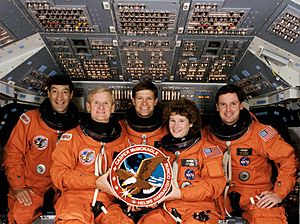STS-54 facts for kids

Endeavour deploys the TDRS-F satellite.
|
|
| Names | Space Transportation System-53 |
|---|---|
| Mission type | TDRS-F satellite deployment Technology |
| Operator | NASA |
| Mission duration | 5 days, 23 hours, 38 minutes, 19 seconds (achieved) |
| Distance travelled | 4,000,000 km (2,500,000 mi) |
| Orbits completed | 96 |
| Spacecraft properties | |
| Spacecraft | Space Shuttle Endeavour |
| Launch mass | 0 kg (0 lb) |
| Landing mass | 92,988 kg (205,003 lb) |
| Payload mass | 18,559 kg (40,916 lb) |
| Crew | |
| Crew size | 5 |
| Members |
|
| Start of mission | |
| Launch date | 13 January 1993, 13:59:30 UTC |
| Rocket | Space Shuttle Endeavour |
| Launch site | Kennedy Space Center, LC-39B |
| Contractor | Rockwell International |
| End of mission | |
| Landing date | 19 January 1993, 13:37:47 UTC |
| Landing site | Kennedy Space Center, SLF Runway 33 |
| Orbital parameters | |
| Reference system | Geocentric orbit |
| Regime | Low Earth orbit |
| Perigee | 302 km (188 mi) |
| Apogee | 309 km (192 mi) |
| Inclination | 28.45a |
| Period | 90.60 minutes |
 STS-54 mission patch  Mario Runco Jr., John H. Casper, Donald R. McMonagle, Susan J. Helms, Gregory J. Harbaugh |
|
STS-54 was a NASA Space Transportation System (Space Shuttle) mission using Space Shuttle Endeavour. This was the third flight for Endeavour, and was launched on 13 January 1993.
Crew
| Position | Astronaut | |
|---|---|---|
| Commander | John H. Casper Second spaceflight |
|
| Pilot | Donald R. McMonagle Second spaceflight |
|
| Mission Specialist 1 | Mario Runco Jr. Second spaceflight |
|
| Mission Specialist 2 | Gregory J. Harbaugh Second spaceflight |
|
| Mission Specialist 3 | Susan J. Helms First spaceflight |
|
Spacewalk
- Harbaugh and Runco – EVA 1
- EVA 1 Start: 17 January 1993
- EVA 1 End: 17 January 1993
- Duration: 4 hours, 28 minutes
Mission highlights
The primary payload was the fifth TDRS satellite, TDRS-F, which was deployed on day one of the mission. It was later successfully transferred to its proper orbit by the Inertial Upper Stage (IUS). Also carried into orbit in the payload bay was a Hitchhiker experiment called the Diffuse X-ray Spectrometer (DXS). This instrument collected data on X-ray radiation from diffuse sources in deep space.
Other middeck payloads to test the effects of microgravity included the Commercial General Bioprocessing Apparatus (CGPA) for-life sciences research; the Chromosome and Plant Cell Division in Space Experiment (CHROMEX) to-study plant growth; the Physiological and Anatomical Rodent Experiment (PARE) to examine the skeletal system and the adaptation of bone to space flight; the Space Acceleration Measurement Equipment (SAMS) to measure and record the microgravity acceleration environment of middeck experiments; and the Solid Surface Combustion Experiment (SSCE) to measure the rate of flame spread and temperature of burning filter paper.
Also, on day five, mission specialists Mario Runco Jr. and Gregory J. Harbaugh spent nearly 5 hours in the open cargo bay performing a series of space-walking tasks designed to increase NASA's knowledge of working in space. They tested their abilities to move about freely in the cargo bay, climb into foot restraints without using their hands and simulated carrying large objects in the microgravity environment.


